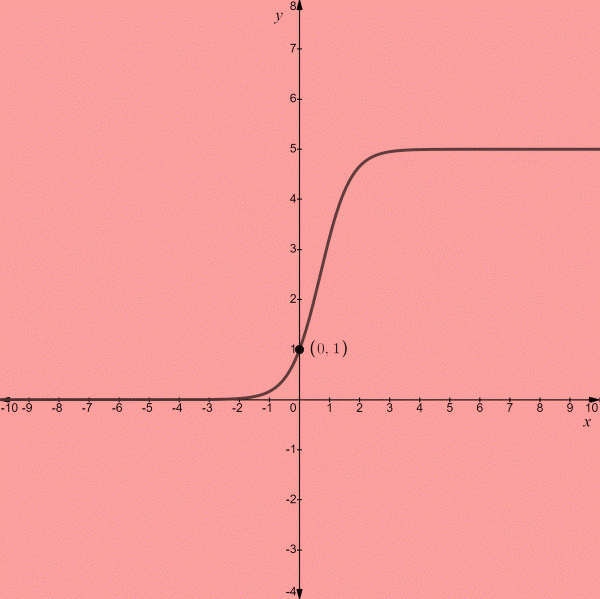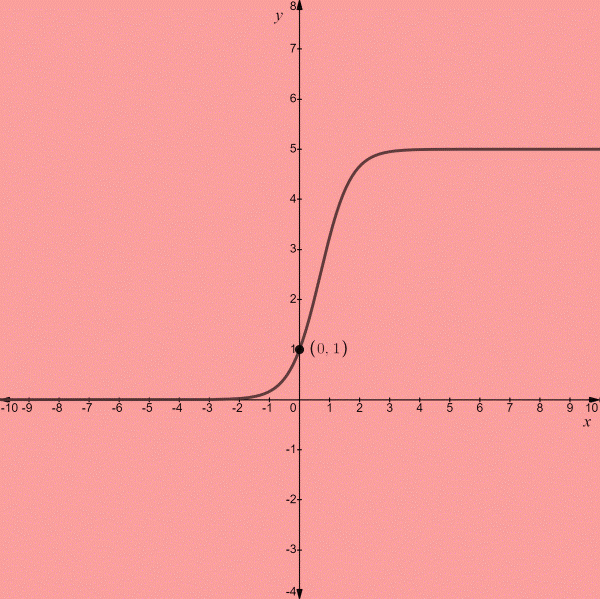
To graph: The given function and to analyze it.

The domain is
The range is
It is a continuous function for all real numbers.
The function is always increasing.
No symmetry.
Bounded below and above.
No local extrema.
Horizontal asymptotes are
No vertical asymptote.
End behavior:
Given:
Calculation:
Comparing
Since
Now, the graph is

The given function is well defined for all real numbers, therefore the domain is
From the graph, it can be seen that the
Therefore, the range is
From the graph, it can be seen that the curve has no breaks or jumps; therefore it is a continuous function for all real numbers.
From the graph, it can be seen that the value of
So, the function is always increasing.
The curve is neither symmetric with the
So the curve has no symmetry.
Bounded below and above.
There are no turning points for the given curve, so there is no local extrema.
Horizontal asymptotes are
No vertical asymptote.
End behavior:
From the graph, it can be seen that
Chapter 3 Solutions
PRECALCULUS:GRAPH...-NASTA ED.(FLORIDA)
- Consider the sequence below: 1 1 1 (a) Express this sequence as a recurrence relation (b) Express this sequence in the form {a}=1 (c) Does this sequence converge or diverge? Justify your answer. Consider the sequence below: 1 1 1 1, 4' 9' 16' (a) Express this sequence in the form {ak}=1 (b) Does this sequence converge or diverge? Justify your answer. Consider the sequence below: 345 2. 4' 9' 16' ·} (a) Express this sequence in the form {a}1 (b) Does this sequence converge or diverge? Justify your answer.arrow_forwardUse the growth rate of sequences theorem to find the limit or state it divergesarrow_forwardcalculate the maximum value of the directional derivativearrow_forward
- 2. A tank with a capacity of 650 gal. originally contains 200 gal of water with 100 lb. of salt in solution. Water containing 1 lb. of salt per gallon is entering at a rate of 4 gal/min, and the mixture is allowed to flow out of the tank at a rate of 3 gal/min. a. Find the amount of salt in the tank at any time prior to the instant when the tank begins to overflow (650 gallons). b. Find the concentration (in pounds per gallon) of salt in the tank when the tank hits 400 gallons. D.E. for mixture problems: dv dt=11-12 dA A(t) dtarrow_forward- Suppose that you have the differential equation: dy = (y - 2) (y+3) dx a. What are the equilibrium solutions for the differential equation? b. Where is the differential equation increasing or decreasing? Show how you know. Showing them on the drawing is not enough. c. Where are the changes in concavity for the differential equation? Show how you know. Showing them on the drawing is not enough. d. Consider the slope field for the differential equation. Draw solution curves given the following initial conditions: i. y(0) = -5 ii. y(0) = -1 iii. y(0) = 2arrow_forward5. Suppose that a mass of 5 stretches a spring 10. The mass is acted on by an external force of F(t)=10 sin () and moves in a medium that gives a damping coefficient of ½. If the mass is set in motion with an initial velocity of 3 and is stretched initially to a length of 5. (I purposefully removed the units- don't worry about them. Assume no conversions are needed.) a) Find the equation for the displacement of the spring mass at time t. b) Write the equation for the displacement of the spring mass in phase-mode form. c) Characterize the damping of the spring mass system as overdamped, underdamped or critically damped. Explain how you know. D.E. for Spring Mass Systems k m* g = kLo y" +—y' + — —±y = —±F(t), y(0) = yo, y'(0) = vo m 2 A₁ = √c₁² + C₂² Q = tan-1arrow_forward
- 4. Given the following information determine the appropriate trial solution to find yp. Do not solve the differential equation. Do not find the constants. a) (D-4)2(D+ 2)y = 4e-2x b) (D+ 1)(D² + 10D +34)y = 2e-5x cos 3xarrow_forward3. Determine the appropriate annihilator for the given F(x). a) F(x) = 5 cos 2x b) F(x)=9x2e3xarrow_forwardTangent planes Find an equation of the plane tangent to the following surfaces at the given points (two planes and two equations).arrow_forward
- Vectors u and v are shown on the graph.Part A: Write u and v in component form. Show your work. Part B: Find u + v. Show your work.Part C: Find 5u − 2v. Show your work.arrow_forwardVectors u = 6(cos 60°i + sin60°j), v = 4(cos 315°i + sin315°j), and w = −12(cos 330°i + sin330°j) are given. Use exact values when evaluating sine and cosine.Part A: Convert the vectors to component form and find −7(u • v). Show every step of your work.Part B: Convert the vectors to component form and use the dot product to determine if u and w are parallel, orthogonal, or neither. Justify your answer.arrow_forwardSuppose that one factory inputs its goods from two different plants, A and B, with different costs, 3 and 7 each respective. And suppose the price function in the market is decided as p(x, y) = 100 - x - y where x and y are the demand functions and 0 < x, y. Then as x = y= the factory can attain the maximum profit,arrow_forward
 Calculus: Early TranscendentalsCalculusISBN:9781285741550Author:James StewartPublisher:Cengage Learning
Calculus: Early TranscendentalsCalculusISBN:9781285741550Author:James StewartPublisher:Cengage Learning Thomas' Calculus (14th Edition)CalculusISBN:9780134438986Author:Joel R. Hass, Christopher E. Heil, Maurice D. WeirPublisher:PEARSON
Thomas' Calculus (14th Edition)CalculusISBN:9780134438986Author:Joel R. Hass, Christopher E. Heil, Maurice D. WeirPublisher:PEARSON Calculus: Early Transcendentals (3rd Edition)CalculusISBN:9780134763644Author:William L. Briggs, Lyle Cochran, Bernard Gillett, Eric SchulzPublisher:PEARSON
Calculus: Early Transcendentals (3rd Edition)CalculusISBN:9780134763644Author:William L. Briggs, Lyle Cochran, Bernard Gillett, Eric SchulzPublisher:PEARSON Calculus: Early TranscendentalsCalculusISBN:9781319050740Author:Jon Rogawski, Colin Adams, Robert FranzosaPublisher:W. H. Freeman
Calculus: Early TranscendentalsCalculusISBN:9781319050740Author:Jon Rogawski, Colin Adams, Robert FranzosaPublisher:W. H. Freeman
 Calculus: Early Transcendental FunctionsCalculusISBN:9781337552516Author:Ron Larson, Bruce H. EdwardsPublisher:Cengage Learning
Calculus: Early Transcendental FunctionsCalculusISBN:9781337552516Author:Ron Larson, Bruce H. EdwardsPublisher:Cengage Learning





